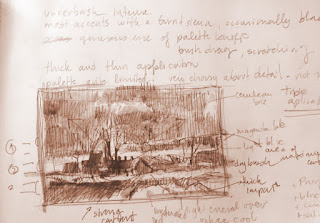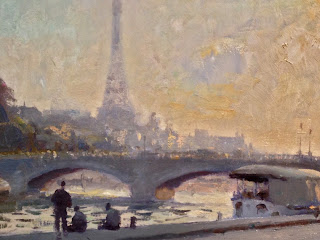I have gone three times to the gorgeous
Portland Gallery in London to see an
Edward Seago exhibition. It must have sold well because it originally had 50 paintings but by the last day only 30 remained. I think the quality of the artwork granted the repeat trip. Seago is probably the painter that has best captured the English light.
 |
| One page of my notes. |
I believe some close observation can yield a few clues as to what makes the paintings great so I came ready with notebook and all. A broad glance is also interesting, many of Seago's paintings have more than a family resemblance. Is it a formula? Is it a technique, a mere mannerism that just happens to be perfectly suited for turbulent skies, choppy waters and old farmhouses? Of course the answer is as elusive as always so, always ready to waste some valuable time in the pursuit of such matters, I tried to jot down some of the clues.
The material aspects of the painting are simple enough. Seago always seems to paint on heavily primed linen canvases. The priming is rough and the brush strokes are visible. The texture of the canvas is concealed by the strokes of the gesso or oil underpaint. The color of the priming, where visible. tends to be a light ocher but may be that's just aging and it was originally a creamy flake white. In one case only (the haystack, below) the canvas had a very rough weave as if made with jute. For the watercolors, similarly sized half sheets of cold press paper.
 |
| Haystack. Notice the very rough canvas weave on a surprisingly smooth sky. |
Composition-wise, some pieces were larger than I expected but he painted in all sizes and formats.
Seago approached all kinds of subjects, including portraits and still life but he excelled at landscapes, specifically traditional English rural landscapes and sea views.
More often than not, about two thirds of the canvas are covered in sky. This is one of the characteristics that make Seago such an English painter. The sky often offers more interest than anything below it, plenty of clouds and turbulence. More about sky compositions later.
 |
| Sky brushed on the primed canvas. Thinly but forcefully glazed paint. |
 |
| Blue 'dragged' over a warm underpainting.The effect is of an evening warm glow. |
 |
| A typical landscape, 2/3 sky. |
One common feature in the landscape pieces is a very skillful use of 'bands'. Basically, if the viewer squints, there are distinct light/shadow bands or wedges. These are not closed but there is always a escape route between them with wisely placed element, a tree, chimney, masts...
The overall effect is that of passing clouds.
 |
| The painting above, "banded" |
The compressed nature of the foreground allows for the artist to create a sense of perspective often enhanced with skillfully placed strokes indicating some roughness of terrain and vanishing lines. Subconsciously, these low lying and casually applied strokes ground the painting enormously. Al the paintings in this article have them so far.
 |
| Fishing village. Observe the great use of perspective grooves on the bottom. |
A great many of Seago's turbulent skies follow a sideways gradation where the darker tones gather on one side and dissolve into mass clouds as they travel to the other side of the picture. His seascapes are greatest when the drama of the sky unfolds. Seago doesn't seem particularly concerned with reflections and water effects but his water is more than believable. As someone that has seen the Thames estuary, it can be quite accurate.
 |
| Another left-to-right stormy sky. Maximum contrast in the foamy bits against the hull. |
|
Seago doesn't do detail. There are rarely spelled-out minutiae in his paintings. His is a world of tonal virtuosity and brush handling magnificence. Many paintings do posses a 'center', a place where maximum contrast and harder edges coalesce. Curiously enough, the darkest darks and greater contrast happen on the mid-range distance, not the closest areas to the viewer. And everything else decreases in intensity around this center of attention. This does not mean there are no other contrast spots but there is clear hierarchy.
The detail of windows, branches, fences, etc is left to impressionistic brush strokes, knife scratches and impasto passages of great beauty.
 |
| Farmhouse group with maximum contrast in the center. Almost like a dark hole radiating outwards. (Detail) |
|
 |
| Detail of a view of Venice |
 |
| Detail of a view of Venice |
 |
| Detail of a view of Venice |
 |
| Look at the cows, just blobs but blobs so well placed and colored. |
Seago's palette is quite sparse. Again, tonality reigns. In this respect he is also very "English". He does not push saturated colors or in-your-face complementaries . On the contrary, he modulates warms and cools within very narrow hue bands (closer to greys than the hues themselves). And yet, the light effects are rich and pleasing. I love how he orchestrates lights blending into shadow across one single surface, a roof, a wall. ...The effect, again, is that of passing clouds, the land subject to the skies.
I am not sure what colors Seago uses so these are some guesses from looking at the limited group of paintings: Some seem obvious, others are more mysterious. He uses an earthy Indian red or burnt sienna for the shadows. These are his warm reds so to speak. Also a very light ocher. Alizarin crimson is his cool red of choice. He often contrasts these with a green. I can't pinpoint what kind but it is close to viridian (an quasi-turquoise cool green), may be emerald green mixed with white? (for grass highlights for example). I would guess his purples are a mix of ultramarine and alizarin crimson. His blues evade me. A mix of black and ultramarine blue? May be he is using a blue grey of some sort. He contrasts these grey blue with a warm dark grey that might be created using raw umber. One thing is clear, he is not shy about black.
 |
| Harbor scene with the center of interest in black and white.Also notice the blue grey and sepia cloud darks. |
Seago was incredibly successful as a landscape painter and became a kind of favorite of the Royals who collected his works shunning other 'trendier' artists. His portraits are lacking sometimes. The exhibit also displayed one still life which I though was a near miss against all the master pieces. Here Seago seems to be using a landscape technique for a completely different subject. Frankly, it looks as if he was trying to get rid of some extra colors. And the result, while not terrible, is quite jejune. This must have been a "rainy day" piece. The flowers show bravura and variety but the dull coloring obliterates the apparent profusion of blooms. Seago seems lost in the clumsy highlights on the stove , the fussy details of the window sill, wall and cast shadow on the back wall. The crowded group of flowers has no room to breath and no volume. Is it a bad painting? Well, for Seago, it is.
 |
| Still life, competent but no cigar. |
But let's not end on that note. Seago is a master and I hope you clicked on the Portland Gallery link to see all the wonders in this exhibit. In my trip to Canada next week, his is the only catalogue I will take with me as a reminder not only of Seago, but of the beauty of the English landscape.
 |
| Deatil. So much with so little. |














No comments:
Post a Comment